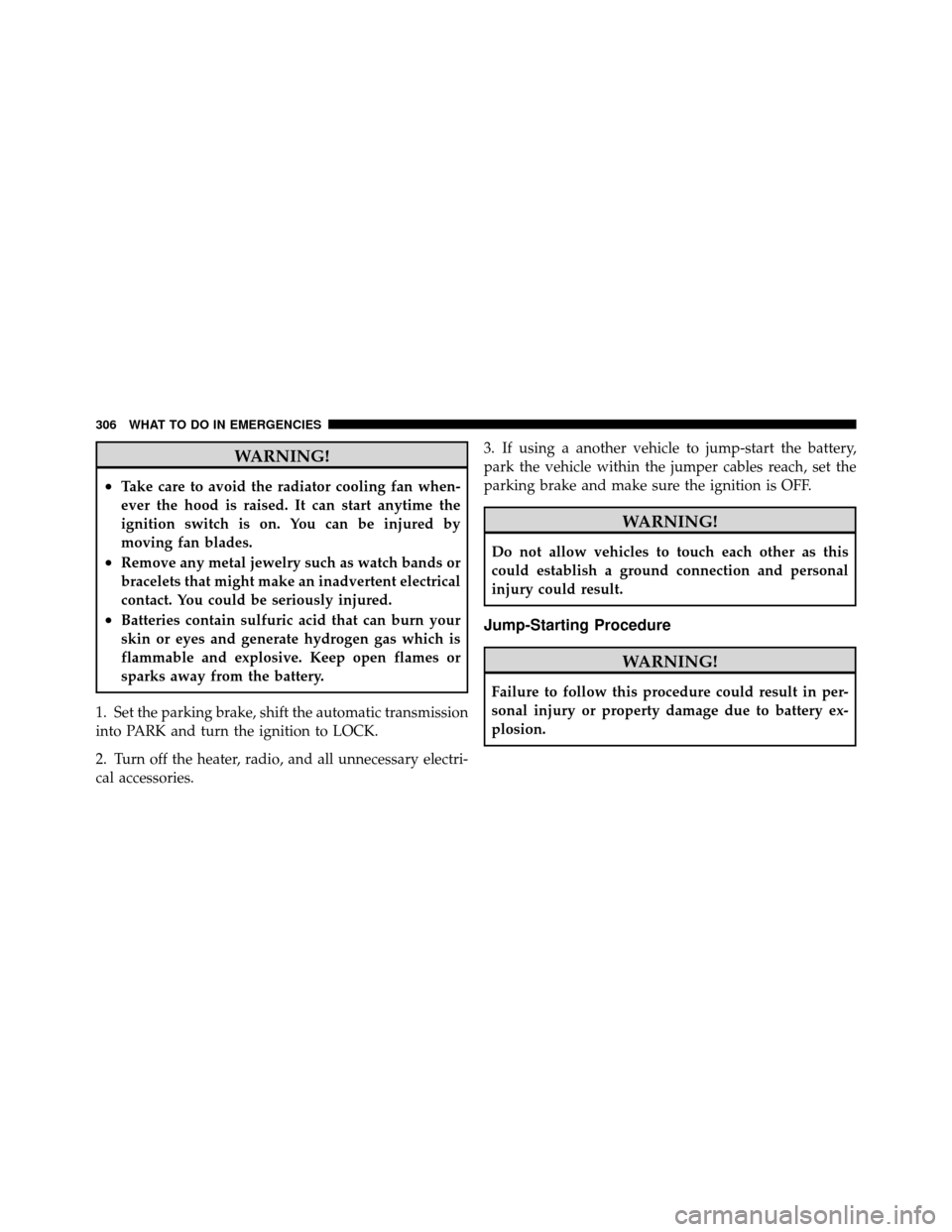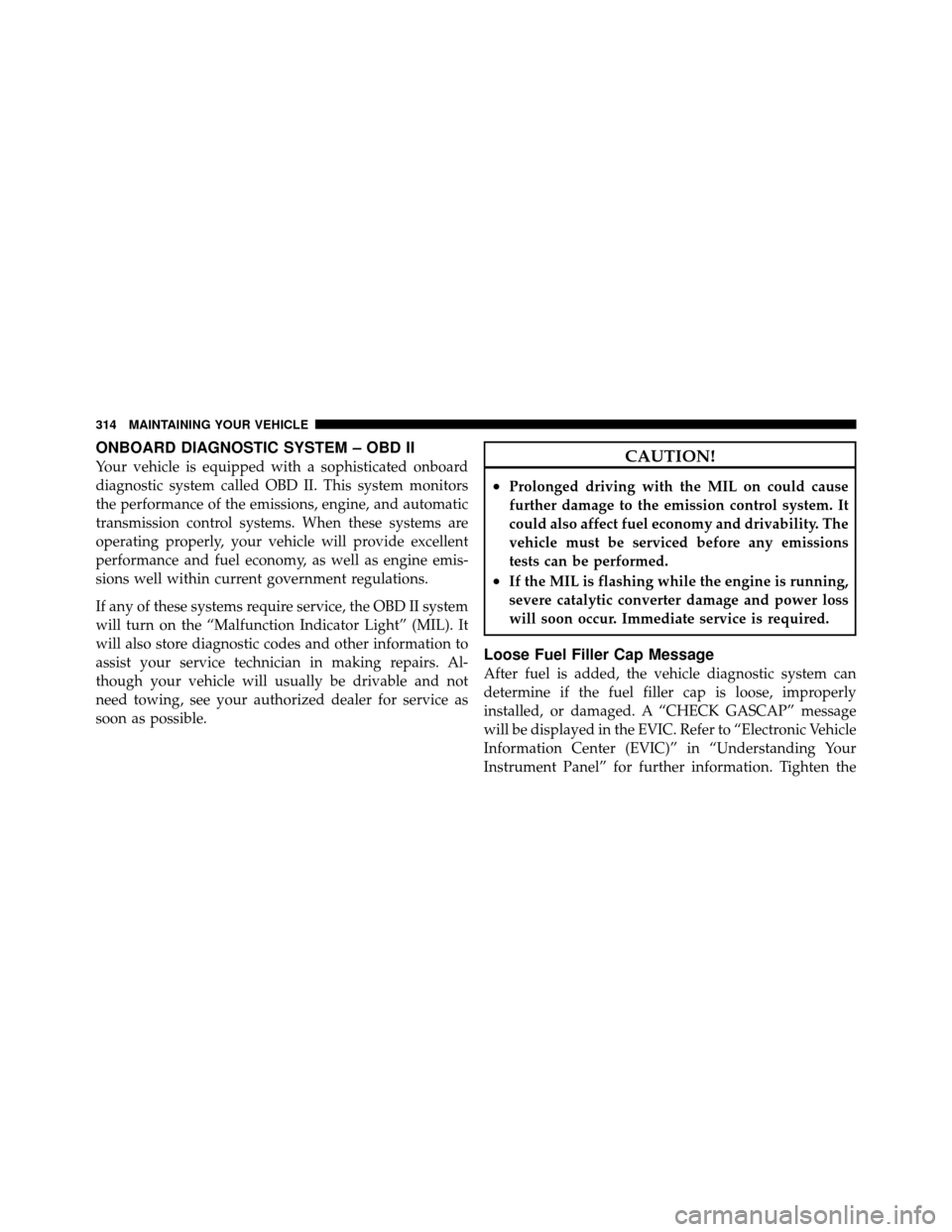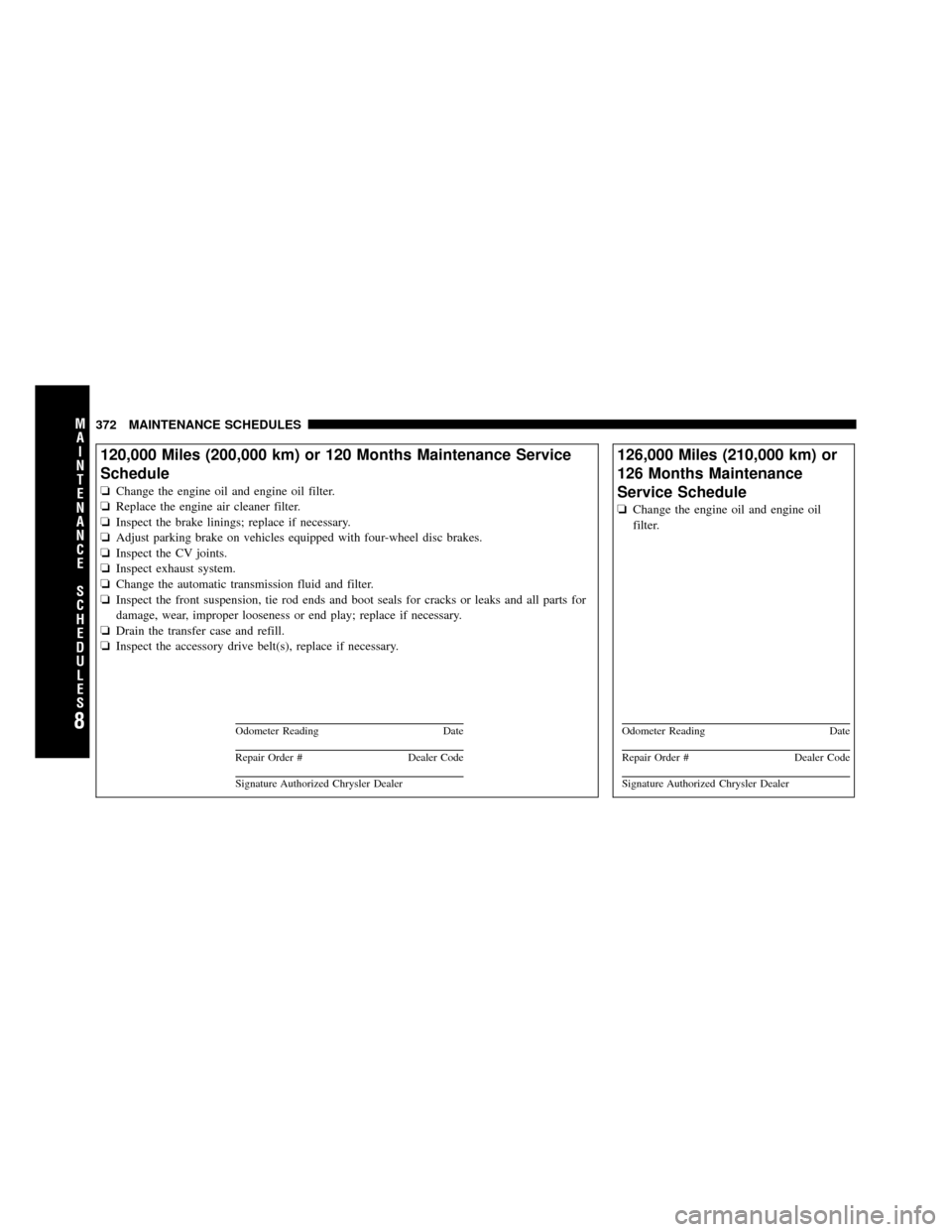Page 307 of 407

WARNING!
•Take care to avoid the radiator cooling fan when-
ever the hood is raised. It can start anytime the
ignition switch is on. You can be injured by
moving fan blades.
•Remove any metal jewelry such as watch bands or
bracelets that might make an inadvertent electrical
contact. You could be seriously injured.
•Batteries contain sulfuric acid that can burn your
skin or eyes and generate hydrogen gas which is
flammable and explosive. Keep open flames or
sparks away from the battery.
1. Set the parking brake, shift the automatic transmission
into PARK and turn the ignition to LOCK.
2. Turn off the heater, radio, and all unnecessary electri-
cal accessories. 3. If using a another vehicle to jump-start the battery,
park the vehicle within the jumper cables reach, set the
parking brake and make sure the ignition is OFF.
WARNING!
Do not allow vehicles to touch each other as this
could establish a ground connection and personal
injury could result.
Jump-Starting Procedure
WARNING!
Failure to follow this procedure could result in per-
sonal injury or property damage due to battery ex-
plosion.
306 WHAT TO DO IN EMERGENCIES
Page 313 of 407

▫Brake System ....................... 334
▫ Automatic Transmission ............... 335
▫ Appearance Care And Protection From
Corrosion .......................... 336
� Fuses .............................. 341
▫ Interior Fuses ....................... 341
▫ Underhood Fuses
(Power Distribution Center) ............. 343
▫ Underhood Fuses
(Integrated Power Module) ............. 346
� Vehicle Storage ....................... 348
� Replacement Bulbs .................... 349
� Bulb Replacement ..................... 349 ▫
High Intensity Discharge Headlamps (HID)
— If Equipped ...................... 349
▫ Halogen Headlamps — If Equipped ....... 350
▫ Front Turn Signal .................... 351
▫ Front Fog Lamp ..................... 352
▫ Rear Tail, Stop, Turn Signal, And Backup
Lamps ............................ 352
▫ Center High-Mounted Stop Lamp
(CHMSL) .......................... 354
� Fluid Capacities ...................... 355
� Fluids, Lubricants, And Genuine Parts ....... 356
▫ Engine ............................ 356
▫ Chassis ........................... 357
312 MAINTAINING YOUR VEHICLE
Page 315 of 407

ONBOARD DIAGNOSTIC SYSTEM – OBD II
Your vehicle is equipped with a sophisticated onboard
diagnostic system called OBD II. This system monitors
the performance of the emissions, engine, and automatic
transmission control systems. When these systems are
operating properly, your vehicle will provide excellent
performance and fuel economy, as well as engine emis-
sions well within current government regulations.
If any of these systems require service, the OBD II system
will turn on the “Malfunction Indicator Light” (MIL). It
will also store diagnostic codes and other information to
assist your service technician in making repairs. Al-
though your vehicle will usually be drivable and not
need towing, see your authorized dealer for service as
soon as possible.CAUTION!
•Prolonged driving with the MIL on could cause
further damage to the emission control system. It
could also affect fuel economy and drivability. The
vehicle must be serviced before any emissions
tests can be performed.
•If the MIL is flashing while the engine is running,
severe catalytic converter damage and power loss
will soon occur. Immediate service is required.
Loose Fuel Filler Cap Message
After fuel is added, the vehicle diagnostic system can
determine if the fuel filler cap is loose, improperly
installed, or damaged. A “CHECK GASCAP” message
will be displayed in the EVIC. Refer to “Electronic Vehicle
Information Center (EVIC)” in “Understanding Your
Instrument Panel” for further information. Tighten the
314 MAINTAINING YOUR VEHICLE
Page 336 of 407

WARNING! (Continued)
•To avoid contamination from foreign matter or
moisture, use only new brake fluid or fluid that
has been in a tightly closed container. Keep the
master cylinder reservoir cap secured at all times.
Brake fluid in a open container absorbs moisture
from the air resulting in a lower boiling point.
This may cause it to boil unexpectedly during hard
or prolonged braking, resulting in sudden brake
failure. This could result in a accident.
•Overfilling the brake fluid reservoir can result in
spilling brake fluid on hot engine parts, causing
the brake fluid to catch fire. Brake fluid can also
damage painted and vinyl surfaces, care should be
taken to avoid its contact with these surfaces.(Continued)
WARNING! (Continued)
•Do not allow petroleum based fluid to contami-
nate the brake fluid. Brake seal components could
be damaged, causing partial or complete brake
failure. This could result in an accident.
Automatic Transmission
Fluid Level Check
Regular automatic transmission fluid level checks are not
required. For this reason the dipstick is omitted.
If you notice fluid loss or transmission slippage or
malfunction, have your authorized dealer check the
transmission fluid level.
7
MAINTAINING YOUR VEHICLE 335
Page 358 of 407
Chassis
ComponentFluid, Lubricant, or Genuine Part
Automatic Transmission MOPAR�ATF+4�Automatic Transmission Fluid or equivalent licensed
ATF+4� product.
Transfer Case MOPAR�NV146 Transfer Case Fluid or equivalent. Usage of other fluid/
lubricants is NOTrecommended.
Axle Differential (Front-Rear) MOPAR� Synthetic Gear & Axle Lubricant SAE 75W-140 (API-GL5) or
equivalent.
Brake Master Cylinder MOPAR�DOT 3 Brake Fluid, SAE J1703 should be used. If DOT 3, SAE
J1703 brake fluid is not available, then DOT 4 is acceptable. Use only rec-
ommended brake fluids.
Power Steering Reservoir This system requires the use of MOPAR� Hydraulic System Power Steer-
ing Fluid or equivalent, which meets Chrysler Material Standard MS-
10838.
7
MAINTAINING YOUR VEHICLE 357
Page 368 of 407

60,000 Miles (100,000 km) or 60 Months Maintenance Service
Schedule
❏Change the engine oil and engine oil filter.
❏ Replace the engine air cleaner filter.
❏ Inspect the brake linings; replace if necessary.
❏ Adjust parking brake on vehicles equipped with four-wheel disc brakes.
❏ Change the automatic transmission fluid and filter(s) if using your vehicle for any of the
following: police, taxi, fleet, or frequent trailer towing.
❏ Drain the transfer case and refill.
❏ Inspect the accessory drive belt(s), replace if necessary.
❏ Flush and replace the engine coolant at 60 months if not done at 102,000 miles
(170 000 km).
❏ Inspect the front suspension, tie rod ends and boot seals for cracks or leaks and all parts for
damage, wear, improper looseness or end play; replace if necessary.
Odometer Reading Date
Repair Order #Dealer Code
Signature Authorized Chrysler Dealer
66,000 Miles (110,000 km) or
66 Months Maintenance
Service Schedule
❏Change the engine oil and engine oil
filter.
Odometer Reading Date
Repair Order #Dealer Code
Signature Authorized Chrysler Dealer
8
M
A I
N T
E
N A
N CE
S
C
H E
D
U L
E
SMAINTENANCE SCHEDULES 367
Page 373 of 407

120,000 Miles (200,000 km) or 120 Months Maintenance Service
Schedule
❏Change the engine oil and engine oil filter.
❏ Replace the engine air cleaner filter.
❏ Inspect the brake linings; replace if necessary.
❏ Adjust parking brake on vehicles equipped with four-wheel disc brakes.
❏ Inspect the CV joints.
❏ Inspect exhaust system.
❏ Change the automatic transmission fluid and filter.
❏ Inspect the front suspension, tie rod ends and boot seals for cracks or leaks and all parts for
damage, wear, improper looseness or end play; replace if necessary.
❏ Drain the transfer case and refill.
❏ Inspect the accessory drive belt(s), replace if necessary.
Odometer Reading Date
Repair Order #Dealer Code
Signature Authorized Chrysler Dealer
126,000 Miles (210,000 km) or
126 Months Maintenance
Service Schedule
❏Change the engine oil and engine oil
filter.
Odometer Reading Date
Repair Order #Dealer Code
Signature Authorized Chrysler Dealer
8
M
A I
N T
E
N A
N CE
S
C
H E
D
U L
E
S372 MAINTENANCE SCHEDULES
Page 389 of 407

ABS (Anti-Lock Brake System)............159,252
Adding Engine Coolant (Antifreeze) .......... 330
Adding Fuel ........................... 287
Additives, Fuel ......................... 285
Adjustable Pedals ........................ 114
Air Conditioner Maintenance ............... 322
Air Conditioning, Operating Tips ............ 232
Air Conditioning Refrigerant ............... 323
Air Pressure, Tires ....................... 274
Airbag .............................. 45,54
Airbag Deployment ....................... 55
Airbag Light ................... 46,53,58,73,159
Airbag Maintenance ....................... 57
Airbag, Side .......................... 51,54
Airbag, Window (Side Curtain) ...........48,51,54
Alarm, Panic ............................ 22
Alarm (Security Alarm) .................17,159
Alterations/Modifications, Vehicle ............. 8
Antenna, Satellite Radio ................... 216 Antifreeze (Engine Coolant)
..............329,355
Disposal ............................ 332
Anti-Lock Brake System (ABS) ............252,255
Anti-Lock Warning Light .................. 159
Anti-Theft System ....................... 159
Appearance Care ........................ 336
Arming Theft System (Security Alarm) ......... 17
Auto Down Power Windows ................ 30
Automatic Dimming Mirror ................. 80
Automatic Door Locks ..................... 28
Automatic Headlights .................... 101
Automatic Temperature Control (ATC) ......... 225
Automatic Transmission ................242,335
Fluid Level Check ..................... 335
Autostick ............................. 245
Auxiliary Electrical Outlet (Power Outlet) ...... 137
Auxiliary Power Outlet ................... 137
Battery ............................... 322
388 INDEX